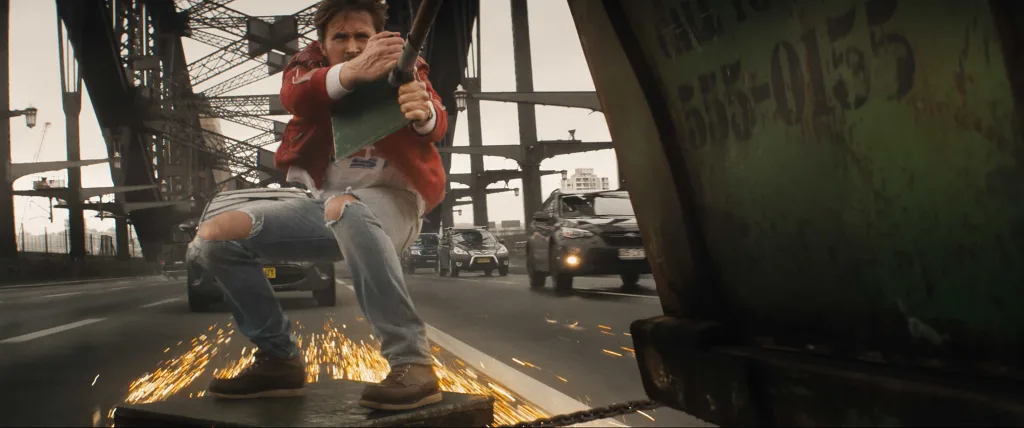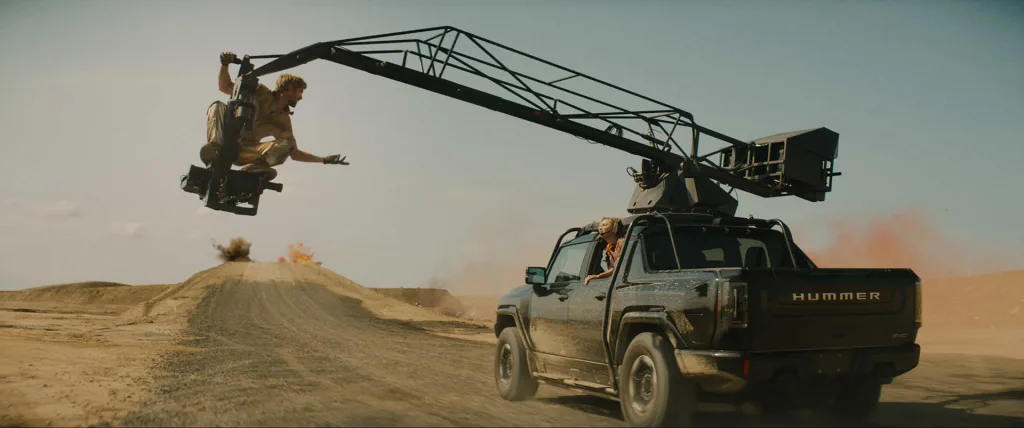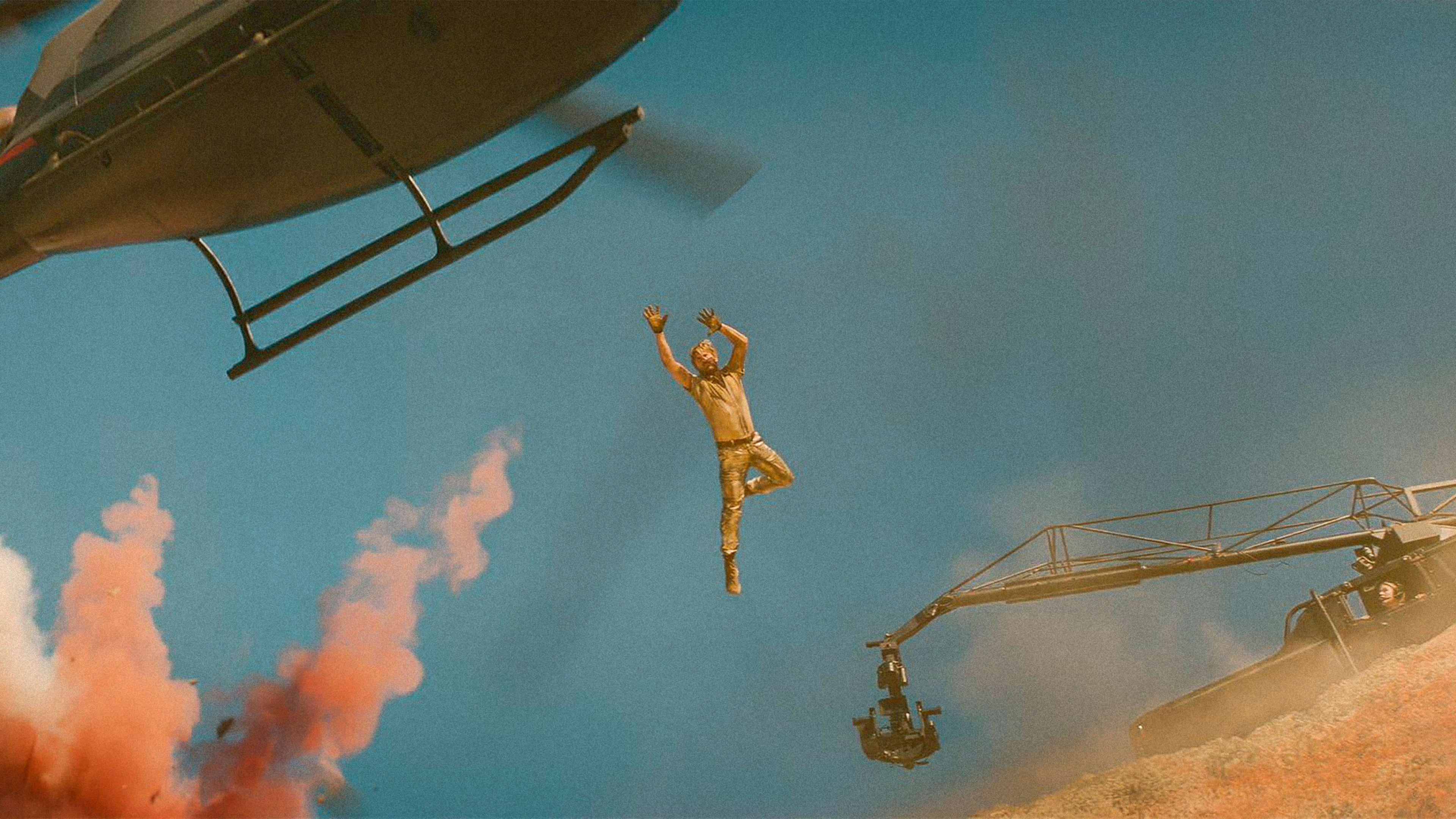The Fall Guy, which is about a Hollywood stuntman, was directed by a former stuntman named David Leitch. It’s was a dream project for Leitch, and it shows. There are fist fights, gun fights, sword fights—so many people get set on fire. (For more on the movie, and how Leitch’s production company 87North is fighting for the stunt industry’s future, see Fast Company‘s full story here.)
Within the first five minutes, the film’s star, Ryan Gosling, plunges 200 feet through a hotel atrium. He’s attached to a cable, but it’s really Gosling. In another sequence, Gosling gets dragged on the lid of a dumpster chained to the back of a truck as it speeds across the Sydney Harbor Bridge at 30 miles per hour. Real truck, real bridge, real Gosling. Toward the end of the film, his character executes a 150-foot fall from a helicopter. No cable this time—and no Gosling, either. (It was a stuntman named Troy Brown.)
At one point in the film-within-a-film, which hits theaters May 3, Gosling’s character executes a cannon roll—stunt vernacular for a flipping car, with a driver inside—in which the car flips eight and a half times. In the real world, the stunt set a Guinness world record, outdoing a cannon roll from 2006’s Casino Royale in which the car flips a mere seven times. Onscreen, though, it’s just another opportunity for Leitch to sneak in a joke about the indignities of being an anonymous stunt performer. After Gosling’s character emerges unscathed from the wreck and slowly makes his way to his trailer, a crew member commends him for his expert daredevilry.
“They give Oscars for that?” the guy asks.
“No,” Colt sighs. “Nope.”

The long quest for gold
Every year on Oscar night, the Academy of Motion Picture Art and Sciences hands out 24 awards. There’s a category for best visual effects. There are categories for best makeup, best costume design, and best art direction. There are categories for sound editing and sound mixing. But currently there is no Oscar category for stunt work or stunt choreography, and it looks like there might not be for the foreseeable future.
It’s not for lack of trying. In 1991, a stunt coordinator named Jack Gill, a legend in the profession, whose career stretches all the way from the first Rambo movie to last year’s Fast X, and who performed stunts on the original Fall Guy television series on ABC back in the early 1980s, was working on a film project with the late director Sidney Lumet when Lumet shared his shock that the Academy Awards had no category for stunt artists, not even during the technical awards ceremony held a few weeks before the live broadcast. “Every single year, for almost 20 years, I was putting a formal request in front of the Academy to establish an Oscar category,” says Gill, now 68, “and we were voted down every single year.”
The board of governors for AMPAS is the Supreme Court of the Oscars, only more secretive, and so Gill was never given an explanation, leaving him to speculate. Was it about preserving the illusion that famous actors and fancy directors do all of this work themselves? Was AMPAS concerned that it might encourage stunt coordinators to take ever-bigger risks in pursuit of a golden statue? Ultimately, he concluded that the real obstacle was something much simpler. “A lot of it is just them not really understanding what we do,” he says. “They think we just take punches and fall down the stairs.”
It’s a bit more complicated than that.

Making it look easy
Stunt work is an entire department on a film production—like, say, makeup, costume design, and art direction—and it’s the stunt coordinator who crafts the action sequences, choreographs them with the actors and stunt performers, executes them on the set, and in most cases actually directs the final versions we all watch on the screen. When you see an action scene in a movie, Leitch says, “nine times out of 10” it was directed by the stunt coordinator and not the nominal director. It’s also, by the way, the stunt coordinator’s job to make sure people don’t die. “That’s a big responsibility,” Gill says. And yet more than three decades since Sidney Lumet first planted the seed in Gill’s head, stunt performers are still watching the Oscars from home.
Gosling, for one, believes this is a travesty. “Stunt performers have been making actors into movie stars for over a century. It’s impossible to separate the history of cinema from the history of action and from the history of stunts.” It’s been impossible since all the way back to the Silent Era, Leitch points out: “Charlie Chaplin, Harold Lloyd, Buster Keaton—they’re all stunt performers.”
Yet on February 8, AMPAS announced it had created the first new Oscar category since adding Best Animated Feature in 2001, and would begin handing it out in 2026: Best Achievement in . . . Casting. “We love our casting directors and we work with them very closely,” says Angelica Lisk-Hann, one of the few Black female stunt coordinators in a white male dominated profession. “But I don’t know that any casting director has ever died from putting two actors together that they think had good chemistry.” Lisk-Hann, who’s based in Toronto, led a successful campaign to get a stunt category added to the Canadian Screen Awards, their Oscars equivalent, and she’s baffled that AMPAS hasn’t followed suit. “I believe it’s going to happen,” Lisk-Hann says. “I just hope I’m not so old that I can’t celebrate the first one with whoever gets it.”
Leitch and and his producing partner, Kelly McCormick, are reluctant to say too much on the subject, because they’re optimistic that the casting branch’s success proves it can be done if you stay the course and follow the right steps. First, casting directors had to create their own branch within the Academy and populate it with enough AMPAS members to justify an entire category. (The casting branch currently has 157 members.) Then they needed to rally the full support of the casting branch and the branch’s executive committee, then they needed to win a majority vote of AMPAS’s awards committee, and then they needed another majority vote from the board of governors. And then they waited. But eventually their campaign was a success, and rather than turning green with envy over the news, Leitch came away encouraged. “It was more like, Oh, there’s hope,” he says.
Choreographing a plan
Like Gill, Leitch and McCormick, who’ve been married since 2014, believe that helping AMPAS governors and Academy voters understand what the job entails is a key part of the campaign, even before they wade into the byzantine procedural process. Step one is rebranding. When it comes to stunt work, most people in the Academy understand the “science” part of AMPAS’s “art and sciences” equation, but they’re a little fuzzy on the “art.” So Leitch and McCormick worked to popularize a new title that emphasizes the creative side of the discipline: “stunt design.”
Step two: awareness. For this year’s Oscar ceremony in March, Leitch and McCormick worked with AMPAS to assemble a tribute montage to stunt work throughout Hollywood history. It was narrated by Gosling and included a glimpse of a young David Leitch crashing through a window in The Bourne Ultimatum, in which he doubled for Matt Damon. Says Gosling, “It was an opportunity to say, look, it’s impossible to separate the history of cinema from the history of action and from the history of stunts.”
Step three is The Fall Guy itself. The film has already been described as a “love letter” to stunt work too many times to count. But it’s much more than that. It’s a two-hour, $125-million tutorial about the stunt profession and a subtle nudge for Oscar recognition. “I feel like the wave is changing,” Leitch says. “We’re really starting to get momentum.” So who knows? Maybe someday soon, Logan Holladay will be the only person alive with a Guinness world record and an Academy Award.
Recognize your brand’s excellence by applying to this year’s Brands That Matter Awards before the final deadline, June 7.
Sign up for Brands That Matter notifications here.
